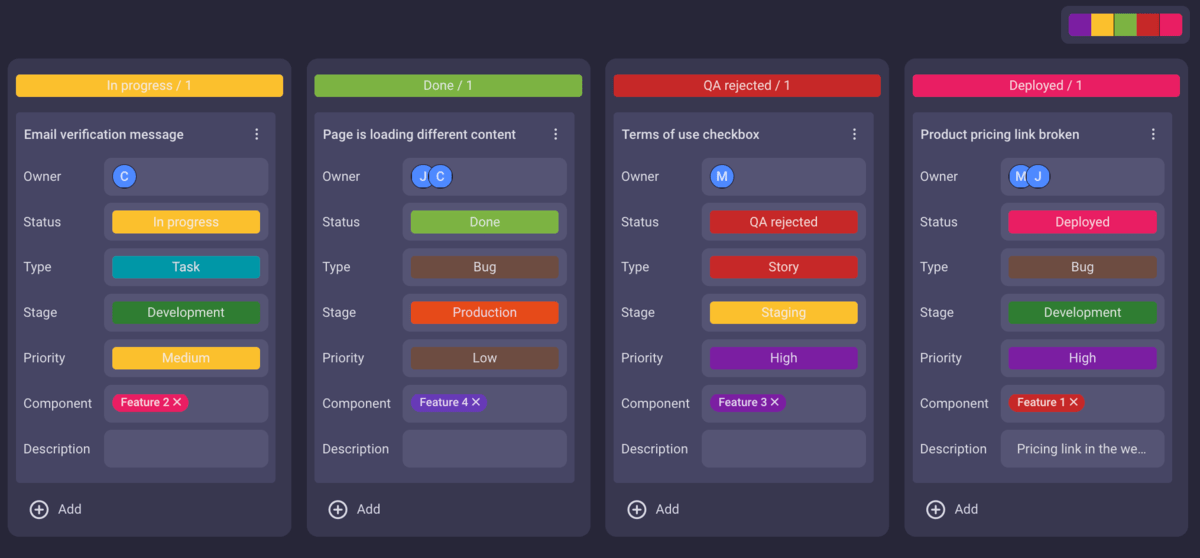Whether you’re a junior or an experienced project manager — every new project represents a new challenge.
Along with other important decisions you’ll need to make as a project manager, at one point you’ll also need to decide what project management style to choose for your project.
In this blog post, we’ll guide you through the 5 most common project management styles and help you find the one that best suits your specific project.
So, keep reading.

In this article:
What is a project management style?
Before we dive into the specifics, let’s first clarify what a project management style actually is.
A project management style refers to a specific approach you use to manage your project.
Before opting for a specific managing style, you should first consider some of your project’s main characteristics:
- Project goals and objectives,
- Project budget,
- Project deadlines,
- Project team’s size and expertise, and
- Your client and stakeholder requests.
After you’ve gathered all this information, you’ll be ready to move on to the next phase — choosing the right management style for your project.
Why is choosing the right project management style important?
If you’re wondering why choosing the right project management style matters in the first place — there’s quite a reasonable explanation for that question.
Choosing your project management style is actually one of the key factors determining whether your project will end in success or failure.
And, here’s how:
- The right style will help you manage your team and workload effectively.
- Coordinated well, your project team members will be more motivated and productive with their tasks.
- Increased motivation and productivity will help build a positive work environment where team members effectively communicate throughout the project.
- It will all result in a successful project, e.g. a successful product launch.
With all this in mind, you can continue with determining the suitable style for your next project.
5 Common project management styles
Now that we’ve established how and why you should focus on your project management style — it’s time to cover the most common styles in more detail.
We’ll cover the 5 most common project management styles:
Reading more about these 5 styles will help you:
- Identify which style you should use, and
- Help you understand both pros and cons of each style.
So, let’s dive in.

Style #1: Waterfall
To determine whether your project management style is waterfall, consider the following questions:
- Is your desired outcome clearly established from the very beginning and can’t be subject to change over time?
- Do you have enough time to focus on details?
If your answers are mainly yes, then waterfall is probably the project management style you should opt for.
Waterfall, sometimes referred to as the classical or traditional approach, follows a linear structure, where a project is clearly divided into 5 project phases:
- Initiation,
- Planning,
- Execution,
- Control, and
- Closing.
In waterfall, there’s a strict order to be followed, where each phase goes after another without any exceptions.
So, you can’t leave one phase unfinished and skip to another one. Each phase needs to end before you can move on to the next one.
For example, if you’re planning a corporate event, you can’t send invites if you haven’t previously determined where the event is going to take place.
Waterfall project management style pros
Here are some waterfall project management style pros.
Pro #1: Waterfall is goal-oriented
In waterfall, the project team will know exactly what they’re going for.
Working with a sense of purpose is important in increasing motivation, and, consequently, achieving higher performance levels.
Pro #2: Waterfall can be implemented in different industries
You can easily apply waterfall in almost any industry, ranging from IT all the way to manufacturing and construction.
Pro #4: Waterfall is detailed
Due to its step-by-step nature, waterfall is excellent for keeping all project details under control at all times.
As project team members remain focused on task-specific details during the entire project development process, there’s less chance for oversights.
Pro #5: Waterfall is reusable
In waterfall, there’s a clear path to follow, and you can follow it as many times as you want.
So, if you’re doing the same project several times, there’s no need to change the style that’s already proven successful.
Waterfall project management style cons
Here are some waterfall project management style cons.
Con #1: Waterfall is not flexible
More often than not, it happens that your plans need to change due to certain factors, such as budget limitations or deadline changes.
In that sense, waterfall’s greatest flaw is that it’s not adaptable.
So, for example, if you gain important customer feedback in the late development stages — you won’t be able to implement this feedback in your project.
In this case, the rigid nature of waterfall could lead to customer dissatisfaction in the future.
Style #2: Agile
One of the co-authors of the Agile manifesto, Jim Highsmith, says:
“Agility is the ability to both create and respond to change in order to profit in a turbulent business environment”.
The agile style in project management is the complete opposite of waterfall, as agile’s main characteristic is adaptability and the ability to respond to change.
Developed in 2001, agile was primarily meant to be used in the software industry.
However, agile quickly started to expand to other industries, such as:
- Manufacturing,
- Education, and
- Healthcare.
To determine whether your project management style is agile — ask yourself the following:
- Do you have overlapping project timelines where different teams work on different project phases at the same time?
- Does your project require frequent modifications along the way?
If the answer is yes — agile is probably your project style.
Agile project management style pros
Take a look at these agile project management style pros.
Pro #1: Agile is flexible
The most valuable characteristic of the agile style is its flexibility.
The ability to respond to change is suitable for complex projects where project requirements often change, even in the later stages of development.
Pro #2: Agile projects result in fewer errors
Being flexible naturally leads to making fewer errors in your project development process, as you can easily go back to a previous project phase and revise it if needed.
Pro #3: Agile enables working within shorter time frames
As multiple teams work on different project areas at the same time, a large project can be broken down into smaller chunks — which decreases the overall time needed to complete the project.
Agile project management style cons
Though agile comes with more advantages, there are some cons as well.
Con #1: Agile can be uncertain
In agile, you can’t know for sure what the final project outcome will look like, as requirements usually change on the go.
Con #2: Agile projects have increased chances of scope creep and gold plating
As changes are frequent in agile, the chances of a project going off track are higher. Your project may fall prey to scope creep or even gold plating.
Hence, project managers should make sure to clearly communicate the gathered project requirements both to stakeholders and project team members.
💡 Plaky Pro Tip
Do you want to find out more about scope creep and gold plating in project management, take a look at these guides:
Style #3: Scrum
To see if scrum is your managing style, consider the following questions:
- Do you have flexible deliverables (i.e. ones that are dictated by the environment) and a flexible schedule?
- Do you manage one or more small teams (i.e. no more than 6 people) that are in constant collaboration?
- Do you have frequent project reviews (usually in 1 to 4-week cycles)?
According to the study “SCRUM Development Process” by Ken Schwaber — scrum consists of 3 phases:
- Pregame — which includes backlog planning, risk assessment, cost estimation, etc.
- Game — which includes sprints (i.e. usually 1 to 4-week repeated cycles in which a product is developed, reviewed, and adjusted), and
- Postgame — when the team prepares for the product release.
💡Plaky Pro Tip:
Are you looking for a project management tool that’s suitable for managing small teams? Take a look at this blog post:
Scrum project management style pros
Now, let’s analyze some scrum project management style pros.
Pro #1: Scrum is highly flexible
Teams can adapt the project whenever it’s necessary and quickly create a system that is responsive to both initial, as well as additional requirements discovered during the ongoing development.
Pro #2: Scrum nurtures productivity and team collaboration
Scrum project management teams are in constant team communication.
In everyday meetings called daily scrums, led by the scrum master, team members can discuss the project and stay updated with what needs to change.
Scrum project management style cons
And, here’s what you need to know about scrum project management style cons.
Con #1: Scrum is not suitable for industries that rely on repetition and predictability.
In projects that have a fixed project scope, set budgets, and strict timelines — scrum teams could potentially struggle to complete the project successfully.
The scrum style is better suited for unique and unpredictable projects and you can never predict what the project management process will look like.
Repeated projects would probably benefit more from a style that’s more fixed in nature, such as waterfall.

Style #4: Lean
If you agree with the following statement by Lean Enterprise Institute, chances are you’d operate well in a lean project management style:
“The core idea behind lean is maximizing customer value while minimizing waste”.
The above statement illustrates the key characteristics of lean, where the focus is on:
- Delivering a product that’s perceived as valuable by the customer,
- Waste elimination, i.e. avoiding all unnecessary actions that don’t add value to the final product, and
- Increased work efficiency.
Lean project management style pros
Here are some lean project management style pros.
Pro #1: Lean lowers costs
Identifying and eliminating your project workflow waste will reduce all unnecessary costs.
Pro #2: Lean raises customer satisfaction
One of the core principles of lean is striving for perfection — this tendency results in satisfied customers and improved brand loyalty.
Lean project management style cons
And, here are some lean project management style cons.
Con #1: Lean might put pressure on the employees
Although striving for perfection and the desire for constant improvement are more than expected in lean — this project management style may be somewhat challenging for project managers, as well as a bit too demanding for the employees.
Style #5: Kanban
Do you find you and your team more productive when your workflow is visually displayed?
If the answer is yes — Kanban might be your project management style.
With Kanban, there’s a strong emphasis on visualization during the project management process.
Also, Kanban workflows can be virtually represented through various project management tools, which makes this style easy to demo.

Kanban project management style pros
When it comes to Kanban project management style pros, they are the following.
Pro #1: Kanban is featured in many project management apps
Kanban doesn’t require any major changes in current team roles (as opposed to, for example, scrum, where you need a scrum master, product owner, etc.), and you can easily try it out with different project management tools, such as Plaky.
Pro #2: Kanban can track progress with task categorization
You can group your Kanban board into different columns, e.g. to do, doing, and done, and, in this way, stay up to date on what each member of the team is doing.
Kanban project management style cons
And, here are some Kanban project management style cons.
Con #1: Kanban might require some training prior to implementation
In the beginning, your team could have trouble navigating the Kanban board, which can make things seem more complicated.
Hence, we recommend you do some research and become familiar with Kanban’s possibilities before actually implementing it.
Conclusion: Choosing the right style can lead to project success
Before starting a new project, as a skilled project manager, you should first find out more details on:
- The project in question, and
- The project management styles you can choose from.
After gathering all this information, you’ll be in a better position to choose one of the common styles that’s right for your project:
- Waterfall,
- Agile,
- Scrum,
- Lean, or
- Kanban.
Paying close attention to determining your style in project management is crucial. Choosing the right style in the beginning might determine the success of your project in the future.
✉️ Can you think of any other important project management styles? If yes, feel free to contact us at blogfeedback@plaky.com, and we may include your ideas in this or any other future blog posts. Also, if you liked this blog post and found it useful, share it with someone you think would also benefit from it.
